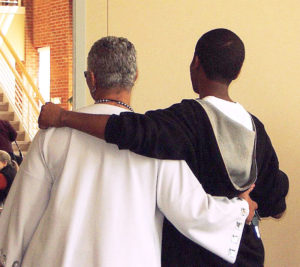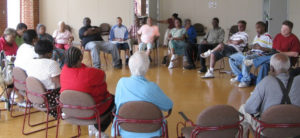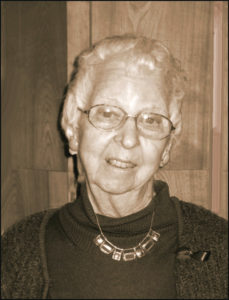
DIVING IN THE MOON
HONORING STORY, FACILITATING HEALING
© Lenora Ucko, PhD
A Storytelling Organization StoriesWork, a Durham, North Carolina non-profit founded by Lenora Ucko in the year 2000, developed a program for group discussion of folk stories to encourage insight and provide tools for coping with life’s challenges. How do we do this? We use the magic and wisdom of age-old folk stories as catalysts in our adaptation of interactive storytelling. Come along as we explain our history, techniques, and accomplishments.Throughout history, life’s “naked truths” have often made people uncomfortable, sometimes embarrassed, even ashamed. No wonder we shy away from looking at our lives with clarity and objectivity. In a folk story however, it is easy to see storybook characters striving for the good life, yet struggling with problems not unlike our own.They too make errors in judgment, poor decisions, and mistaken actions. When we see human foibles, missed opportunities, poor judgment played out by characters in a folk story, we cannot help but reflect on ourselves in similar situations. That’s when we begin to understand and consider different solutions to life’s challenges. That is the magic of the folk story!How do we reach the magic of the folk story in storytelling sessions?
First we create a safe, nonthreatening, nonjudgmental atmosphere. In this accepting,
respectful environment, we tell a short folk story, and then ask probing questions about
the story and its characters. We welcome all points of view and encourage free and
frank discussion about the storybook characters and their relationships. Discussion
focuses exclusively on what people see in the story. We do not talk about any
participant’s personal life or emotional problems.There is a twist. No one can make a mistake in our sessions! There are no right or wrong answers. Everyone’s view is acceptable and respected, even if strange or fantastic. As a result, discussions take off with enthusiasm; thoughts long buried are expressed; differing views are appreciated; and there is a surprising amount of humor and laughter. Imaginative questions, formulated by our group facilitators about the story’s characters, are at the heart of the technique and the reason for its success.
How did we get started?
It was a long winding road over a period of many years. In the 1980’s, as an anthropologist, I was teaching in the Graduate School of Social Work at Adelphi University in New York State. Because of the large and varied immigrant populations in New York, students needed to learn how to deal with clients from many different cultures.Little did I realize that classroom teaching and book learning would have little effect on the students’ success working with young Vietnamese women in the Adelphi University Social Work Clinic. Quickly, I scouted for alternative teaching tools, most of which turned out to be as ineffective as what I had been doing. Something wholly different was needed. That’s when I began to tell folk stories in class, from different parts of the world. Not only were the students beginning to understand on a deeper level, but after taking the stories into the Clinic, they came back to class smiling from ear to ear. Everyone loved the stories, which soon became the vehicle for establishing rapport between client and social worker. And I was beginning to understand the power of the folk story.
From that beginning, I started to draw on folk stories at every opportunity. With a grant from the National Endowment for the Humanities, I introduced folk stories into several social work courses, held a faculty seminar, and gave talks at community meetings on cultural issues facing immigrants. During my sabbatical year at the Fort Bragg School for International Studies in North Carolina, I used folk stories in cross-cultural training for military personnel. And the stories always worked!When I retired from Adelphi and moved to Durham, North Carolina in 1986, more opportunities presented themselves. One was my volunteer work with counselors at the Orange/Durham Coalition for Battered Women. It became clear to me that the counselors needed better tools with which to help battered women. At support group meetings, women usually talked about themselves, but the discussion did not seem to go anywhere. I offered to train the counselors to use folk stories as a safe vehicle for intensive recognition of domestic abuse issues while avoiding the discomfort of self-disclosure.
Because folk stories about ongoing marriages are full of abusive situations, here was a
way for battered women to talk openly and frankly, but in terms of the storybook
characters. Let me give you an example of a support group meeting at which I and a
counselor were co-facilitators.

The Reluctant Young Woman
The women were starting to congregate for their regular support group meeting when a pale anxious young woman came in. She asked if she could sit at the back of the room, listen without participating, and leave if she became too uncomfortable. Assured that this was acceptable, she slid into a chair and sat with downcast eyes as the program began. When the group leader introduced a folk story for discussion, the young woman, somewhat surprised, looked up. Once the discussion started and it was clear that the atmosphere was safe, non-threatening, and non-judgmental, the young woman began, at first hesitatingly and soon more confidently, to offer her comments about the woman in the story. She participated throughout the session, with tears streaming down her cheeks. Finally, as the session was coming to a close, the young woman dried her eyes and said simply, “Now I can tell you my story.” She had married her high school sweetheart a year ago, enjoyed a few months of happiness, and then was devastated when her husband turned more and more controlling and violent. As she walked to the door, she turned and said, “Thanks for letting me stay. I would like to come back.”
How did the organization grow?
News of our success spread to other domestic violence organizations, and upon
request, I held training sessions for their personnel. Even before our nonprofit was
established, I trained staff for the North Carolina Coalition against Domestic Violence,
Interact of Raleigh, and groups in Pittsboro, Morganton, and Asheville, North Carolina.
I began to think about publishing a manual of instructions when someone said to me,
“You know, we are entering the 21st Century. Why don’t you set up a website instead?”
At this time (1999), websites were beginning to appear, and I gave it some thought. Then I learned that to apply for grant money for a website, one should be a non-profit
organization, and soon the non-profit StoriesWork was born. And we received a large
grant to create a website about our method of interactive storytelling!
The rest, as they say, is history. Over time, we expanded from domestic violence to
such areas as aging, parenting, diversity, substance abuse, health, after-school
programs, management issues, and more. In addition to staff training, we held
storytelling workshops for people struggling with various life challenges. Some
programs were in Spanish. And videoconferences were available in and outside the
United States.
What is the training for facilitators?
Facilitators need both a knowledge of what to do and the skill to do it. The first is
rather straightforward and most people interested can learn intellectually what the
technique is. We have also developed a manual of instruction which we use in training.
However – and this cannot be emphasized too strongly – to be skilled at successful
facilitating is a challenge! We literally have to change facilitators’ mind sets before they
can function as discussion guides. Why? Because the skill needed goes against our
normal way of dealing with the world.
As we grow up, we are taught to be judgmental in viewing the world. Often even
without conscious thought, we find ourselves automatically deciding what is right and
what is wrong in the world around us. Second, we may look for “politically correct”
ideas and criticize those that we feel are not. And finally, we bring our own opinions
and ideas to every discussion and feel impelled to defend our position. These habits are
powerful and very hard to repress. But they must be discarded at least temporarily to
be successful at our interactive storytelling. Only then can facilitators be completely
neutral, accept all ideas and answers from participants, and successfully encourage and
guide the discussion.
The result is that our technique has worked with participants of all racial and ethnic
groups, socio-economic levels, educational achievement, philosophic outlook, and/or
personal difficulty.
What makes our method universally successful?
For over 15 years, our interactive storytelling technique has reached a wide variety of
audiences – cancer patients, ex-offenders, parents, immigrants, managers, seniors,
college students, business people, and many more Every group we met with reported
an appreciation of our technique and its value.
The answer lies not in the particular stories we select to tell, nor in the way we tell them. We look instead to the atmosphere created anew at each storytelling session, the unspoken recognition of a shared humanity between us and our participants. And the realization that our ancestors, by bequeathing to us the simple narratives of their lives – the folk stories we use – reveal human problems and solutions that barely change over time and place. And these old stories help all of us to understand and cope with our own daily challenges. Recognizing this “oneness” throughout history and across the world creates a bond among all of us at our storytelling sessions.
Is there anything more we add to the atmosphere? Yes, there is: acceptance, respect, and non-judgment.
We offer complete acceptance of participants and their answers and comments. We
respect everyone’s right to her/his own opinion and ideas. And we do not sit in
judgment.

Easier said than done. In our daily life, we are accustomed to judging people and ideas,
to reject what we disagree with, and to devalue what we don’t like. As facilitators, we
have to rearrange our thinking and operate in a completely neutral fashion. As
discussion leaders, we ask probing questions about the stories, but we have no
answers. It is up to the participants to think about and discuss each other’s varied
reactions.
At the beginning of each storytelling session, we establish the atmosphere by saying:
“You cannot make a mistake here.” Why? Because there are no right or wrong answers!
Every answer is worthy, regardless of differences of opinion. And all comments are
acceptable no matter how fantastic. At first participants seem skeptical. But when it
becomes clear from our actions that we mean what we say, you can feel a sense of
relief and comfort among participants. Not only is there complete acceptance and
mutual respect, but also valuable and sometimes startling exchanges of views.
Let me illustrate with a story that inspired many different opinions.
What is a Miracle?
In a very small town high up in the mountains, everyone was excited. For the
first time, a holy man from the big city was coming to visit. All the men and
women congregated on the village green to greet this dignitary. When he
arrived, he noticed an expectant look on everyone’s face. Ah yes, he
understood – they were awaiting a miracle!
He immediately beckoned to a nearby tree. But the tree did not move. The
holy man said, “Oh, well,” and he beckoned again. Again the tree stood firm.
Once again the holy man said, “Oh, well.”
The people began to murmur, “What kind of holy man is that? Where is the
miracle?” At this, the holy man walked over to the tree.
The people were clearly disappointed. Then the holy man turned to them
and said gently, “We must not be arrogant. If the tree cannot come to me, I
must go to the tree.”
Here is a sample question from a facilitator and answers from participants.
What is the miracle in this story?
Answers:
- The miracle is that a holy man from the big city would make the journey up into
the mountains to visit a tiny village. - The miracle is that a tree grows at so high an altitude.
- The miracle is that women are allowed to join men in greeting the holy man.
- The miracle is that there is no miracle in the story, and yet we are trying to find
one. - The miracle is that the holy man found a way to offer wisdom in a seemingly
impossible situation.
Note that all answers are very different from each other. No two people are exactly
alike, and each person sees something else in a story. By accepting every answer as
worthy, our minds are open to appreciate different ways of looking at the world. And by
not being judged, participants feel competent and accepted for who they are. Each
answer encourages exchanges among participants and leads to deeper insights.
What stories do we use?
We are often asked where we find stories and how we assign their use. Finding the
stories is not difficult. There is a vast published literature of folk stories from all over the
world. And the amount of stories is endless. We consult this literature and select for
our database stories that are concerned with interpersonal relationships and life
challenges. These stories have no author and no copyright. They have been told and
retold from generation to generation and from century to century. Often changed from
one storyteller to another, many variations can be found in different parts of the world.
We also find “urban legends,” which are anecdotes relating to modern life that have no
author, but are told from one person to another about purported daily life odd
happenings. Many of these find their way into current publications.
Given this vast reservoir of useful material, we have no problem amassing stories for
our programs. Selecting and adapting stories for a particular program however is a
thoughtful process. The main requirement is that the stories allow for exploring various
aspects of a topic. Here is a story we often use in sessions with older adults.
The Old Woman and her Doctor
This elderly woman came to see her doctor once again, and with her usual
complaints.
Arthritis, lack of sleep, poor appetite. Once again, the doctor suggested a
heating pad for her knees, warm milk at bedtime, a change of diet. “No, no,” the
woman protested.
“You know I tried them all. And they don’t work.” After making other
recommendations which the woman promptly rejected, the frustrated doctor
finally said as gently as he could, “You know, my dear woman, I cannot make
you any younger.”
At that the woman became furious. “What makes you think I want you to make
me younger?” she shouted. “What I want is for you to help me get older!”
Probing questions:
- What made the woman so angry?
- What did she really want from the doctor?
- What did the doctor want from his patient?
- Did this doctor and patient understand each other?
- What could have helped the situation?
Our unique storytelling practice adds to the tradition of modifying stories and storytelling from time to time and place to place. In prehistoric times, adults often sat together in the evening to talk about their life and history. In the modern world, storytelling is found in entertainment, education, counseling, public speaking, business, and a wide variety of other venues. Many families hand down family stories from one generation to the next. In the health field, and in other fields as well, we find a treasury of anecdotes, case histories, and the recounting of significant accomplishments. To this long history, we are pleased to add the StoriesWork
distinctive use of interactive storytelling as our contribution for people to reconsider their life challenges and to control their own destiny.
In these and in many other circumstances, stories do work!
Postscript: We greatly revise stories, shortening and modifying them for our Interactive Storytelling technique. We also use “urban legends,” anecdotes relating to purported happenings in modern life that have no author and are verbally repeated from person to person for a while and then disappear.
“What is a Miracle? ” can be found in “Mullah’s Miracle” Daenecke, Eric. Tales of Mullah
Nasir-ud- Din: Persian Wit, Wisdom and Folly. New York: Exposition Press, ©1960. p.
31.
“The Old Woman and Her Doctor” is an urban legend.
Lenora Ucko, PhD, anthropologist, folklorist, 
storyteller, founded and directed the nonprofit,
StoriesWork, for many years. She studied and wrote
about gender roles in folk stories and marriage
relationships in different cultures. She was invited to
speak about stories and marriage at the United
Nations Committee on the Family and received awards
from the National Storytelling Network, Soroptomist
International and Interact of Raleigh. Lenora is quick
to see the relevance of stories to problems in the
modern world. Her recent publications include a
coauthored story book, The Mayonnaise Jar, and a
companion discussion guide called, Let’s Talk about
The Mayonnaise Jar and Bullying. Lenora can be
reached at sverdlikpress.com
